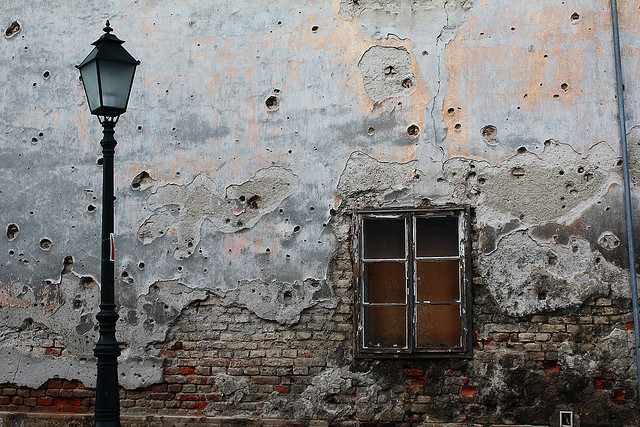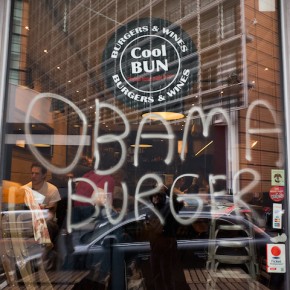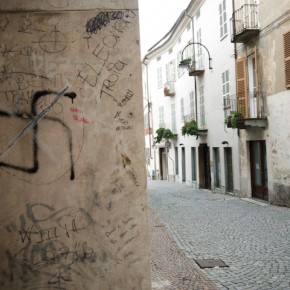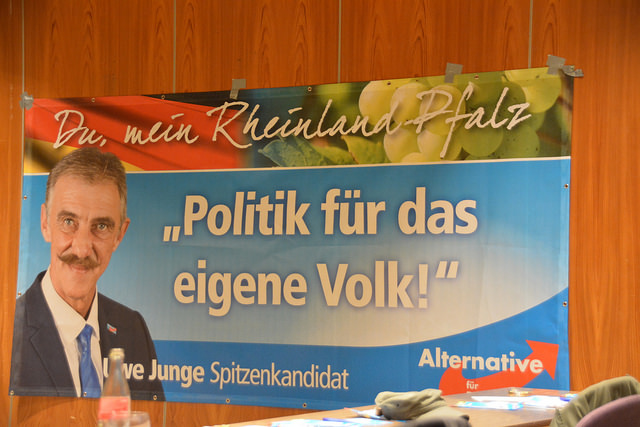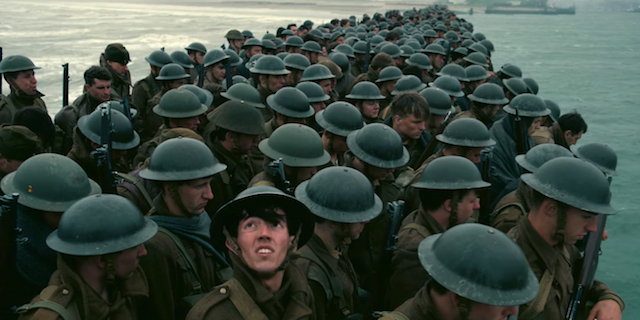Viktor produced a thick volume from the Yugo’s trunk for me to read while he drove. Inside were maps and graphics of red replacing blue with each subsequent year, reminiscent of the famous map of Palestinian displacement. The landscape itself was not so different either. Mostly flat and rocky with few imposing hills, its main products are olives and rustic cheeses from goats and sheep. We stopped at a roadside market to get a few groceries for lunch.
The next town was a little bit more encouraging. Its main street featured both a grocery store and a bar, the only place open for miles where the town’s few residents spend their slow days playing pool and nursing beers and aperitifs. Our server was a hip young girl, who Viktor speculated to be from Novi Sad, visiting her family for the summer. I began to ask him some questions about the war, the ethnic cleansing, and the return of Serbians to the area. He quickly stopped me. “We can talk in the car,” he said. “Not here. People don’t want to hear about this.”
In Sibinek, too, Viktor was paranoid about talking too loudly. The town was small enough that everyone knew something about their neighbors, and Viktor’s half-Serbian heritage made him a target of suspicion. Even at his home, he curbed his usually powerful speeches when it came to specific cases of ethnic cleansing. At one point, he even closed his window for the remainder of a conversation.
We had a picnic of local cheese and apples in the Devrske’s graveyard. Viktor was obsessed by the Cyrillic-engraved stones, noting peculiarities about the dates, the names, and what they might have meant.
Our next stop was the larger town of Kistanje. One of Viktor’s favorite monuments once stood here, a monolith depicting the participation of different nationalities in the Partisan effort, complete with a plaque listing all of their names together. In 1998 the monument was bombed by Croatian fascists. Ten years later it was rebuilt, but without the names of the Partisans, and two separate plaques in Croatian and Serbian.
“What’s the point,” Viktor complained. “Why did they even rebuild it?”
WINNETOU
A roadside attraction in the desolate region would be strange enough, but at a juncture on the way to Kistanje I saw something even stranger: a tiny imitation Wild West ghost town, complete with teepees, an imitation saloon, and a makeshift steakhouse/souvenir shop. As we slowly drove past the bizarre spectacle, we wondered whether it was a desperate attempt at a tourist trap, or if it was sort of subtle protest camp.
Viktor’s first reaction was that it was a celebration of the 1963 film Winnetou, a German-Yugoslavian produced Western (Burek Western?) adapted from the works of Karl May.
The eponymous Winnetou is one of May’s main protagonists, an Apache chief who struggles to keep his morality and humanity amongst the capitalist hedonism of American expansion. Filmed in nearby Krka National Park, it’s possible the proprietors of Apache village were hoping to lure some May-loving German tourists their way. On the other hand, Viktor speculated that the synchronicities of the genocide of the American Indians, the ethnic cleansing of Croatian Serbians, and the added element of glib German tourists were perhaps not lost on the locals.

“The Serbians who remain here identify with the Indians portrayed in Winnetou. In their minds, they are noble indigenous freedom fighters with their lands constantly threatened.”
In the 2013’s film The Act of Killing, Indonesian paramilitary members reminisce about their spree of torturing and murdering suspected Communists during the 1970s. They claimed American Westerns as a major source of inspiration for their gang-like enthusiasm for bloodshed. Hitler was a major fan of Karl May, connecting Winnetou’s moral purity to the racial purity of Aryans. And of course, there is George W. Bush’s faux-salt-of-the-earth cowboy character, an act that played out in the run-up to the wars in Afghanistan in Iraq where he promised to “smoke the terrorists out of their holes,” leaving hundreds of thousands dead in the process.
I haven’t seen Winnetou, or read any of Karl May’s books, but what is it about the American West that seemed to define an entire century of colonialism, genocide, and ethnic cleansing? Perhaps something about the manifest destiny, the frontier, the stoic, gun-toting male voyaging without conscious into the desert.
MASSACRE
We had one more monument to visit in the nearby town of Varivode, population 124 (up from 93 in 2001.) Unlike the other imposing and modern monuments, this one looked more like a roadside memorial or shrine to some minor saint. It was short, placed in a grassy island in the middle of the road, and made of stone, tile, and plywood painted white. Nine names are written in Cyrillic and Latin characters.

Two months after Operation Storm, the final battle of the war between Croatia and Serbia’s breakaway territories in which the rebels were overrun and their population cleansed by the Croatian military, soldiers entered Varivode late at night and killed nine elderly villagers. The massacre became an iconic example of the murders, arson, sabotage of lands, and slaughter of livestock committed by Croats during the war to deter Serbs from returning. For the few Serbs that stayed, largely those too old or sick to leave, one out of four was killed. Few have returned, and those who do live in incredible poverty, with almost no local economy and lingering oppression from their Croatian neighbors.
Like the monument in Kistanje, the memorial was destroyed by a Croatian veteran, and only recently was rebuilt.
THE CLOISTER
Perhaps feeling a little sorry that he hadn’t taken me to a traditional tourist site, Viktor’s last stop on our trip was the Serbian Orthodox monastery bordering Krka. During Operation Storm, the Croatian Army looted and destroyed part of the 600 year old site. Restored and reopened in 2001, it was the healthiest Serbian institution I saw that day. The courtyard was peaceful, surrounded by attractive frescoes and the occasional black-robed and bearded monk hustling from place to place. I said something about the beautiful fountain in the middle of the courtyard, built from a boulder now thickly covered with moss, but heard no response. I looked over my shoulder for Viktor, and I realized I was alone.
He stayed outside. For leftists in ex-Yugoslavia, religion played such an integral part in garnering support for the senseless wars that many hate Christianity as much as they despise fascists. When I left the courtyard, Viktor was staring at one of the monk’s cars—a shiny new Lexus with a crucifix-shaped air freshener dangling from the rear-view mirror.
“This is their vow of poverty?” he asked with a smirk. “This is a year’s income for an entire village in this area.”
We walked down into the valley behind the monastery with brief discussion, but we were both entirely worn out after the hours of driving, walking, talking, and listening. Only Luka still ran freely, seemingly irrepressible in his old age. We got to a pier and dipped our feet into the cold water.
We looked across the river into an area of the park with no path and no tourists. It was an area untouched since its establishment in 1985, a type of socialist monument whose lush flora could absorb bullets and shells, unlike the marble of the Partisan monuments.
I asked the questions I couldn’t before at the Devrske café. What happened to Croats living in Serbia? What happened in ‘Bosnia? Why was it necessary to kill the elderly? Why are Serbs returning? Are things getting better now after the uprising in Bosnia and Herzegovina, and after the floods? To Viktor, I must have sounded like a child, and a bad student at that. He did his best to answer, but I quickly got the sense he was worn-out, and that there was far too much to explain.
After a few minutes of silence, we heard the monks faintly chanting.
Photographs courtesy of Xavier Tredjeu, Gustavo Medde, and dmytrok. Published under a Creative Commons license.
